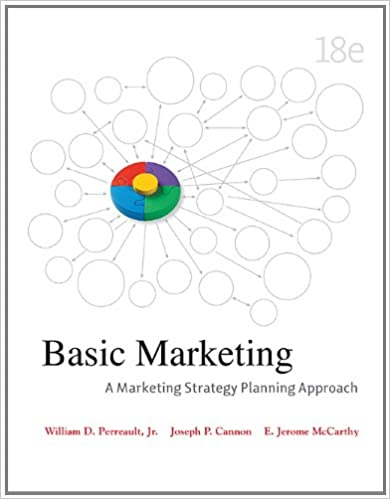
BASIC MARKETING 18th Edition by Jerome McCarthy William Perreault, Joseph Cannon
Edition 18ISBN: 978-0077577193
BASIC MARKETING 18th Edition by Jerome McCarthy William Perreault, Joseph Cannon
Edition 18ISBN: 978-0077577193 Exercise 10
This problem lets you see the dynamics of break-even analysis. The starting values (costs, revenues, etc.) for this problem are from the break-even analysis example in this chapter (see Exhibit 17-8).
The first column computes a break-even point. You can change costs and prices to figure new break-even points (in units and dollars). The second column goes further. There you can specify target profit level, and the unit and dollar sales needed to achieve your target profit level will be computed. You can also estimate possible sales quantities, and the program will compute costs, sales, and profits. Use this spreadsheet to address the following issues.
a. Vary the selling price between $1.00 and $1.40. Prepare a table showing how the break-even point (in units and dollars) changes at the different price levels.
b. If you hope to earn a target profit of $15,000, how many units would you have to sell? What would total cost be? Total sales dollars? (Note: Use the right-hand ["profit analysis"] column in the spreadsheet.)
c. Using the "profit analysis" column (column 2), allow your estimate of the sales quantity to vary between 64,000 and 96,000. Prepare a table that shows, for each quantity level, what happens to average cost per unit and profit. Explain why average cost changes as it does over the different quantity values.
The first column computes a break-even point. You can change costs and prices to figure new break-even points (in units and dollars). The second column goes further. There you can specify target profit level, and the unit and dollar sales needed to achieve your target profit level will be computed. You can also estimate possible sales quantities, and the program will compute costs, sales, and profits. Use this spreadsheet to address the following issues.
a. Vary the selling price between $1.00 and $1.40. Prepare a table showing how the break-even point (in units and dollars) changes at the different price levels.
b. If you hope to earn a target profit of $15,000, how many units would you have to sell? What would total cost be? Total sales dollars? (Note: Use the right-hand ["profit analysis"] column in the spreadsheet.)
c. Using the "profit analysis" column (column 2), allow your estimate of the sales quantity to vary between 64,000 and 96,000. Prepare a table that shows, for each quantity level, what happens to average cost per unit and profit. Explain why average cost changes as it does over the different quantity values.
Explanation

This question doesn’t have an expert verified answer yet, let Examlex AI Copilot help.
BASIC MARKETING 18th Edition by Jerome McCarthy William Perreault, Joseph Cannon
Why don’t you like this exercise?
Other Minimum 8 character and maximum 255 character
Character 255


